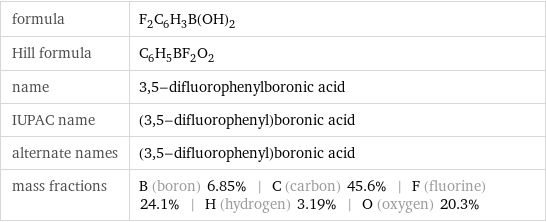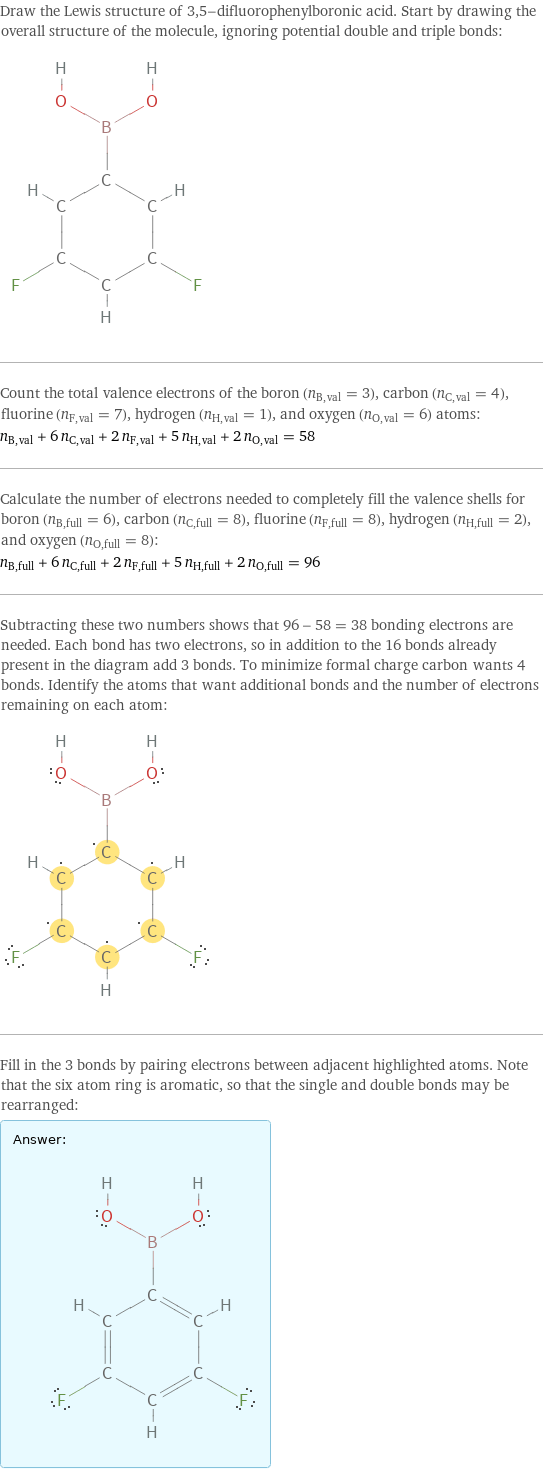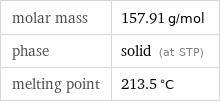Input interpretation

3, 5-difluorophenylboronic acid
Chemical names and formulas

formula | F_2C_6H_3B(OH)_2 Hill formula | C_6H_5BF_2O_2 name | 3, 5-difluorophenylboronic acid IUPAC name | (3, 5-difluorophenyl)boronic acid alternate names | (3, 5-difluorophenyl)boronic acid mass fractions | B (boron) 6.85% | C (carbon) 45.6% | F (fluorine) 24.1% | H (hydrogen) 3.19% | O (oxygen) 20.3%
Lewis structure

Draw the Lewis structure of 3, 5-difluorophenylboronic acid. Start by drawing the overall structure of the molecule, ignoring potential double and triple bonds: Count the total valence electrons of the boron (n_B, val = 3), carbon (n_C, val = 4), fluorine (n_F, val = 7), hydrogen (n_H, val = 1), and oxygen (n_O, val = 6) atoms: n_B, val + 6 n_C, val + 2 n_F, val + 5 n_H, val + 2 n_O, val = 58 Calculate the number of electrons needed to completely fill the valence shells for boron (n_B, full = 6), carbon (n_C, full = 8), fluorine (n_F, full = 8), hydrogen (n_H, full = 2), and oxygen (n_O, full = 8): n_B, full + 6 n_C, full + 2 n_F, full + 5 n_H, full + 2 n_O, full = 96 Subtracting these two numbers shows that 96 - 58 = 38 bonding electrons are needed. Each bond has two electrons, so in addition to the 16 bonds already present in the diagram add 3 bonds. To minimize formal charge carbon wants 4 bonds. Identify the atoms that want additional bonds and the number of electrons remaining on each atom: Fill in the 3 bonds by pairing electrons between adjacent highlighted atoms. Note that the six atom ring is aromatic, so that the single and double bonds may be rearranged: Answer: | |
Basic properties

molar mass | 157.91 g/mol phase | solid (at STP) melting point | 213.5 °C
Units

Chemical identifiers

CAS number | 156545-07-2 PubChem CID number | 2734338 PubChem SID number | 24870772 SMILES identifier | B(C1=CC(=CC(=C1)F)F)(O)O InChI identifier | InChI=1/C6H5BF2O2/c8-5-1-4(7(10)11)2-6(9)3-5/h1-3, 10-11H MDL number | MFCD01318138